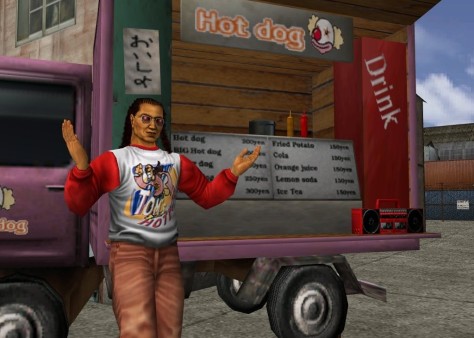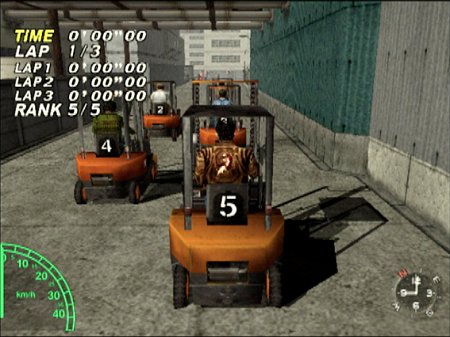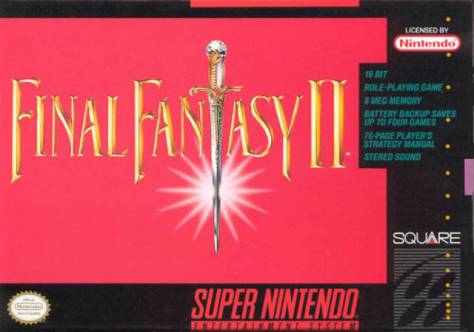
Shenmue definitely has a reputation that precedes it. At the time and for many years afterwards, it was reportedly the most expensive video game ever produced. With respectable sales that weren’t near the expected numbers, it assisted in ending Sega’s home console development. Nonetheless, the game received high praise critically and is routinely cited as an influential video game. Shenmue has always been on a personal bucket list of mine and I’m finally able to check it off.
Before being consumed by Virtua Fighter, Yu Suzuki was a titan at Sega. He was the major figure behind a plethora of the company’s marquee arcade titles in late 1980s. Space Harrier, Hang-On, OutRun, After Burner – this guy had a knack for designing video games. I’m not intending to short shrift Virtua Fighter either. It’s one of the most respected fighting game series and has a dedicated fan base. Shenmue is Yu Suzuki’s magnum opus however, and it oozes his passion. In the manual, in the credits, in the way he describes the game – the fictional world and gameplay elements that comprise the game were undoubtedly personal muses for the man.
Shenmue takes place in Yokosuka, Japan during the winter of 1986. The game is a tale of revenge, following Ryo Hazuki as he tracks down the mysterious man who murdered his father. Ryo’s father, Iwao, was a master martial artist whose dojo was in a remote suburb of Yokosuka. Iwao’s murderer, Lan Di, is a mysterious Chinese martial artist who had an unknown grudge against Ryo’s father. Not only that, but Lan Di’s ties to a Chinese criminal syndicate further complicate the affair as Ryo investigates the mysterious Chinese man.

Exploration and puzzle solving are the primary focuses of Shenmue’s gameplay, although there is a minor emphasis placed on brawling. Knowing practically nothing of Lan Di, Ryo takes to the neighborhoods and shops of Yokosuka to find and follow up on any leads he can. Interacting with dozens of townsfolk, it was easy for me to get immersed in the day to day heartbeat of the city. Ryo’s leads introduced him to friends and foes from practically all of the storefronts, and since the game had a strong adherence to portraying a realistic setting, I’d have to make sure to check in with individuals at the corresponding hour of the day, or night.
I was dead set on making a physical map of the shopping district and outlying neighborhoods, but by the time I sketched it out, I was familiar enough with the areas to abandon the prospect. The neighborhoods contained little to experience but the shopping district was densely packed with unique individuals and storefronts. To an outsider, such as myself, it was a joy to experience what this slice of Japan might’ve been like in the late 1980s – minus Ryo’s Sega Saturn.

The puzzle solving aspect of the gameplay revolved mostly around locating the proper individual to speak with. Then, utilizing the information they provided with Ryo. Be it an area to check or another individual to speak with. I didn’t find monotony in constantly seeking someone out, only to be pointed elsewhere. It didn’t seem like it was filler content. For the most part, every lead advanced the plot, if only slightly.
One related point is what I interpret as shoddy localization. The game is fully voice-acted and everyone will respond to Ryo if he prompts them. However, a lot of the dialog doesn’t sound natural. It’s as if the script was translated directly from the Japanese original with no localization. Translating the game is one part of the localization process, but another would be making it so the characters speak realistically. Some lines of dialogue didn’t make functional sense to me. Then again, the game contained a friendly Jamaican hot dog vendor named Tom, and he doesn’t make a lot of sense either.

The third pillar of the gameplay is the action sequences. I’d break these down into two categories: brawling and quick-timer events (QTEs). Both were infrequent, but an important aspect nonetheless. Brawling was reminiscent of the fighting system from Virtua Fighter – deep and very precise. Ryo had a wealth of moves at his disposal, but I was able to meander on by button mashing. This was helped by the fact that there were about twelve fights across the entire game. QTEs are now commonplace in video games and we have Shenmue to thank for that! They were pioneered in the game and allowed the player to experience a handful of exciting action sequences and actually feel some involvement. They were also infrequent.
After a dozen or so hours, I had brought Ryo to the end of his quest in Yokosuka. Shenmue ended with a slew of events, beginning with Ryo getting a job at the Yokosuka docks. This entailed me operating a forklift for about a week of in-game time which translated to a few hours. It was a decidedly dull climax to the game, but it was far from over. At the docks Ryo got a better understanding of the criminal syndicate Lan Di was aligned with.
Eventually, Ryo was too late to confront Lan Di who was already heading back to China. Ryo’s story was just beginning, but I wasn’t left unfulfilled. Shenmue capped off with an exciting motorcycle ride through the nighttime Yokosuka highway system. The goal was to reach the docks which lead to an epic brawl against 70+ gang members. Ryo intent on pursuing Lan Di to China and many of the interactions with Ryo’s friends and family were heartfelt.

With Shenmue off my bucket list, I’m anxious to begin Shenmue II on the Xbox. The series was originally proposed as a trilogy so my journey with Ryo will end with an unfulfilled cliffhanger upon completion of the second game. Heck, I’ll probably convert into one of those crazies trying to get a grassroots effort started to develop Shenmue III. It wouldn’t be a surprise. The game came out nearly a decade-and-a-half ago and it still feels modern. Its combination of storytelling, setting, and gameplay meld together to form one of the most realized and worthwhile video games out there.











